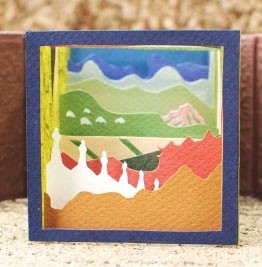 After making a tunnel book for my last prompt challenge word, I spent some time looking at other tunnel books as well as directions. Here’s some of what I found:
After making a tunnel book for my last prompt challenge word, I spent some time looking at other tunnel books as well as directions. Here’s some of what I found:
![]() A tunnel or peephole book is a set of pages bound into accordions on two sides and viewed through a central opening. Scenery or shapes are cut out of the pages and then assembled in layers. Inspired by theatrical stage sets, this book form dates from the mid-eighteenth century and continues to be popular.
A tunnel or peephole book is a set of pages bound into accordions on two sides and viewed through a central opening. Scenery or shapes are cut out of the pages and then assembled in layers. Inspired by theatrical stage sets, this book form dates from the mid-eighteenth century and continues to be popular.
![]() The photo is of Kara Russo’s Tibet as I Remember It — I especially liked this one as it uses color and shape in much the way I tried to use them in my own recent model.
The photo is of Kara Russo’s Tibet as I Remember It — I especially liked this one as it uses color and shape in much the way I tried to use them in my own recent model.
![]() I made my book using an accordion spine on the left and right, made out of thin white Japanese paper so light would come through the sides. The National Museum of Women in the Arts has PDF directions for this sort of structure.
I made my book using an accordion spine on the left and right, made out of thin white Japanese paper so light would come through the sides. The National Museum of Women in the Arts has PDF directions for this sort of structure.
![]() Ed Hutchins has instructions for a slightly more involved, one sheet tunnel book. On his website, his article Exploring Tunnel Books includes a history of tunnel books and a photo gallery of example books. There are good discussions of what makes the structure a book, rather than a novelty piece, how various artists have adapted the form, and how one might incorporate text.
Ed Hutchins has instructions for a slightly more involved, one sheet tunnel book. On his website, his article Exploring Tunnel Books includes a history of tunnel books and a photo gallery of example books. There are good discussions of what makes the structure a book, rather than a novelty piece, how various artists have adapted the form, and how one might incorporate text.
![]() Book artist and teacher Carol Barton has been instrumental in popularizing tunnel books with book artists. She has a gallery of tunnel books on her website.
Book artist and teacher Carol Barton has been instrumental in popularizing tunnel books with book artists. She has a gallery of tunnel books on her website.
![]() Beth Lee has a nice list of links to tunnel books she likes.
Beth Lee has a nice list of links to tunnel books she likes.
![]() Rand Huebsch wrote an article for the Bone Folder on tunnel books.
Rand Huebsch wrote an article for the Bone Folder on tunnel books.
![]() And lastly, click here to see all the tunnel book images Google has collected.
And lastly, click here to see all the tunnel book images Google has collected.
